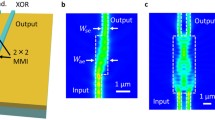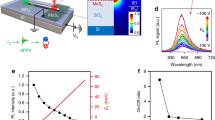Abstract
Surface plasmon polaritons (SPPs) are crucial for the development of next generation information and communication technologies. However, the ohmic losses inherent to all plasmonic devices seriously limit their practical application in on-chip photonic communications. Here, loss compensation of SPPs and their application in photonic logic processing was demonstrated in rationally designed organic/silver nanowire heterostructures. The heterostructures were synthesized by inserting silver nanowires (AgNWs) into crystalline organic microwires, which served as a microscale optical gain medium. These heterostructures with large organic/metal interfacial areas ensured the efficient energy transfer from excitons to SPPs. Gain for subwavelength SPPs in the heterostructure was achieved through stimulated emission of strongly confined SPPs. Furthermore, cascade gain was performed to realize basic nanoscale photonic devices, such as Boolean logic units. The results would pave an alternative avenue to incorporating SPP-enhanced devices into hybrid photonic circuitry.
摘要
表面等离子体激元(SPPs)对于下一代信息通信技术的发展 至关重要. 然而, SPPs器件固有的欧姆损耗限制了它们在片上光学 通讯中的实际应用. 本工作中, 我们在合理设计的有机/金属纳米线 异质结中实现了SPPs的损耗补偿及其在光学逻辑运算中的应用. 通过将银纳米线(AgNWs)插入结晶有机微丝中来合成异质结构, 并将其用作微米级光学增益介质. 所制备的异质结具有较大的有 机/金属界面面积, 能确保从激子到SPPs的高效能量转移. 异质结 构中亚波长SPPs的增益是通过强烈限制SPPs的受激发射实现的. 此外, 我们还实现了SPPs的级联增益, 并将其用于构建微纳光子学 器件, 例如Boolean逻辑单元. 相关结果为具有SPPs增强功能的器件 用于混合光子学回路提供了新的思路.
Similar content being viewed by others
References
Lal S, Link S, Halas NJ. Nano-optics from sensing to waveguiding. Nat Photon, 2007, 1: 641–648
Eaton SW, Fu A, Wong AB, et al. Semiconductor nanowire lasers. Nat Rev Mater, 2016, 1: 16028
Oulton RF, Sorger VJ, Zentgraf T, et al. Plasmon lasers at deep subwavelength scale. Nature, 2009, 461: 629–632
Sidiropoulos TPH, Röder R, Geburt S, et al. Ultrafast plasmonic nanowire lasers near the surface plasmon frequency. Nat Phys, 2014, 10: 870–876
Noginov MA, Zhu G, Belgrave AM, et al. Demonstration of a spaser-based nanolaser. Nature, 2009, 460: 1110–1112
Wei H, Wang Z, Tian X, et al. Cascaded logic gates in nanophotonic plasmon networks. Nat Commun, 2011, 2: 387
Zhang Q, Li G, Liu X, et al. A room temperature low-threshold ultraviolet plasmonic nanolaser. Nat Commun, 2014, 5: 4953
Fang Z, Zhu X. Plasmonics in nanostructures. Adv Mater, 2013, 25: 3840–3856
Akimov AV, Mukherjee A, Yu CL, et al. Generation of single optical plasmons in metallic nanowires coupled to quantum dots. Nature, 2007, 450: 402–406
Nezhad MP, Simic A, Bondarenko O, et al. Room-temperature subwavelength metallo-dielectric lasers. Nat Photon, 2010, 4: 395–399
Wang D, Yang A, Wang W, et al. Band-edge engineering for controlled multi-modal nanolasing in plasmonic superlattices. Nat Nanotech, 2017, 12: 889–894
Tseng ML, Yang J, Semmlinger M, et al. Two-dimensional active tuning of an aluminum plasmonic array for full-spectrum response. Nano Lett, 2017, 17: 6034–6039
Galanzha EI, Weingold R, Nedosekin DA, et al. Spaser as a biological probe. Nat Commun, 2017, 8: 15528
Liu N, Wei H, Li J, et al. Plasmonic amplification with ultra-high optical gain at room temperature. Sci Rep, 2013, 3: 1967
Li DB, Ning CZ. Giant modal gain, amplified surface plasmon-polariton propagation, and slowing down of energy velocity in a metal-semiconductor-metal structure. Phys Rev B, 2009, 80: 153304
Khurgin JB. How to deal with the loss in plasmonics and metamaterials. Nat Nanotechnol, 2015, 10: 2–6
Fedyanin DY, Krasavin AV, Arsenin AV, et al. Surface plasmon polariton amplification upon electrical injection in highly integrated plasmonic circuits. Nano Lett, 2012, 12: 2459–2463
Gather MC, Meerholz K, Danz N, et al. Net optical gain in a plasmonic waveguide embedded in a fluorescent polymer. Nat Photon, 2010, 4: 457–461
De Leon I, Berini P. Amplification of long-range surface plasmons by a dipolar gain medium. Nat Photon, 2010, 4: 382–387
Wu X, Xiao Y, Meng C, et al. Hybrid photon-plasmon nanowire lasers. Nano Lett, 2013, 13: 5654–5659
Kéna-Cohen S, Stavrinou PN, Bradley DDC, et al. Confined surface plasmon-polariton amplifiers. Nano Lett, 2013, 13: 1323–1329
Ambati M, Nam SH, Ulin-Avila E, et al. Observation of stimulated emission of surface plasmon polaritons. Nano Lett, 2008, 8: 3998–4001
Grandidier J, des Francs GC, Massenot S, et al. Gain-assisted propagation in a plasmonic waveguide at telecom wavelength. Nano Lett, 2009, 9: 2935–2939
Kress SJP, Cui J, Rohner P, et al. A customizable class of colloidal-quantum-dot spasers and plasmonic amplifiers. Sci Adv, 2017, 3: e1700688
Chen YH, Li J, Ren ML, et al. Direct observation of amplified spontaneous emission of surface plasmon polaritons at metal/dielectric interfaces. Appl Phys Lett, 2011, 98: 261912
Yan R, Pausauskie P, Huang J, et al. Direct photonic-plasmonic coupling and routing in single nanowires. Proc Natl Acad Sci USA, 2009, 106: 21045–21050
Takazawa K, Inoue J, Mitsuishi K, et al. Micrometer-scale photonic circuit components based on propagation of exciton polaritons in organic dye nanofibers. Adv Mater, 2011, 23: 3659–3663
Fang HH, Yang J, Feng J, et al. Functional organic single crystals for solid-state laser applications. Laser Photonics Rev, 2014, 8: 687–715
Liao Q, Jin X, Zhang H, et al. An organic microlaser array based on a lateral microcavity of a single j-aggregation microbelt. Angew Chem Int Ed, 2015, 54: 7037–7041
Li YJ, Lv Y, Zou CL, et al. Output coupling of perovskite lasers from embedded nanoscale plasmonic waveguides. J Am Chem Soc, 2016, 138: 2122–2125
Pyayt AL, Wiley B, Xia Y, et al. Integration of photonic and silver nanowire plasmonic waveguides. Nat Nanotech, 2008, 3: 660–665
Li YJ, Hong Y, Peng Q, et al. Orientation-dependent exciton-plasmon coupling in embedded organic/metal nanowire hetero-structures. ACS Nano, 2017, 11: 10106–10112
Paul A, Zhen YR, Wang Y, et al. Dye-assisted gain of strongly confined surface plasmon polaritons in silver nanowires. Nano Lett, 2014, 14: 3628–3633
Park S, Kwon OH, Kim S, et al. Imidazole-based excited-state intramolecular proton-transfer materials: Synthesis and amplified spontaneous emission from a large single crystal. J Am Chem Soc, 2005, 127: 10070–10074
Wang F, Gong Z, Hu X, et al. Nanoscale on-chip all-optical logic parity checker in integrated plasmonic circuits in optical communication range. Sci Rep, 2016, 6: 24433
Cheng X, Wang K, Huang S, et al. Organic crystals with near-infrared amplified spontaneous emissions based on 2’-hydroxychalcone derivatives: Subtle structure modification but great property change. Angew Chem, 2015, 127: 8489–8493
Henary MM, Fahrni CJ. Excited state intramolecular proton transfer and metal ion complexation of 2-(2’-hydroxyphenyl)benzazoles in aqueous solution. J Phys Chem A, 2002, 106: 5210–5220
Lv Y, Li YJ, Li J, et al. All-color subwavelength output of organic flexible microlasers. J Am Chem Soc, 2017, 139: 11329–11332
Zou CL, Sun FW, Xiao YF, et al. Plasmon modes of silver nanowire on a silica substrate. Appl Phys Lett, 2010, 97: 183102
Zu S, Li B, Gong Y, et al. Active control of plasmon-exciton coupling in MoS2-Ag hybrid nanostructures. Adv Opt Mater, 2016, 4: 1463–1469
Noginov MA, Zhu G, Mayy M, et al. Stimulated emission of surface plasmon polaritons. Phys Rev Lett, 2008, 101: 226806
Guo X, Qiu M, Bao J, et al. Direct coupling of plasmonic and photonic nanowires for hybrid nanophotonic components and circuits. Nano Lett, 2009, 9: 4515–4519
Cho CH, Aspetti CO, Turk ME, et al. Tailoring hot-exciton emission and lifetimes in semiconducting nanowires via whispering-gallery nanocavity plasmons. Nat Mater, 2011, 10: 669–675
Li YJ, Yan Y, Zhang C, et al. Embedded branch-like organic/metal nanowire heterostructures: Liquid-phase synthesis, efficient photon-plasmon coupling, and optical signal manipulation. Adv Mater, 2013, 25: 2784–2788
Yan Y, Zhang C, Zheng JY, et al. Optical modulation based on direct photon-plasmon coupling in organic/metal nanowire heterojunctions. Adv Mater, 2012, 24: 5681–5686
Bozhevolnyi SI, Volkov VS, Devaux E, et al. Channel plasmon subwavelength waveguide components including interferometers and ring resonators. Nature, 2006, 440: 508–511
Acknowledgements
This work was supported by the Ministry of Science and Technology of China (2017YFA0204502) and the National Natural Science Foundation of China (21533013 and 21790364).
Author information
Authors and Affiliations
Contributions
Zhao YS conceived the idea and supervised the project. Lv Y designed the experiments and prepared the materials. Lv Y and Xu FF performed the optical measurements. Lv Y, Xu FF and Wang K put forward the theoretical model and contributed to the theoretical calculations. Lv Y, Li YJ and Zhao YS analyzed the data. Lv Y, Li YJ, and Zhao YS wrote the manuscript. All authors discussed the results and commented on the manuscript.
Corresponding author
Additional information
Conflict of interest
The authors declare that they have no conflict of interest.
Yuanchao Lv received his PhD degree in physical chemistry at the Institute of Chemistry, Chinese Academy of Sciences (ICCAS) in 2018. He is currently an associate professor in the College of Chemistry and Materials Science, Fujian Normal University. His research interests are the photonic properties of porous micro/nanomaterial, organic/metal hybrid systems and their application as miniaturized photonic devices.
Yong Sheng Zhao received his PhD degree in 2006 at ICCAS. After that, he joined the University of California at Los Angeles (UCLA) and Northwestern University as a postdoctoral fellow. In 2009, he returned to ICCAS as a professor of chemistry. His research interests include the controllable synthesis of low-dimensional organic materials, photophysical and photochemical processes, as well as the fabrication and performance optimization of photonic/optoelectronic devices.
Supporting Information
40843_2019_1216_MOESM1_ESM.pdf
Loss Compensation of Surface Plasmon Polaritons in Organic/Metal Nanowire Heterostructures toward Photonic Logic Processing
Rights and permissions
About this article
Cite this article
Lv, Y., Xu, F.F., Wang, K. et al. Loss compensation of surface plasmon polaritons in organic/metal nanowire heterostructures toward photonic logic processing. Sci. China Mater. 63, 1464–1471 (2020). https://doi.org/10.1007/s40843-019-1216-5
Received:
Accepted:
Published:
Issue Date:
DOI: https://doi.org/10.1007/s40843-019-1216-5




